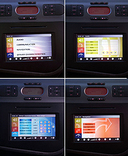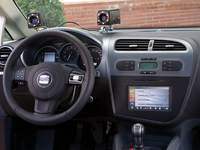SEAT Presents "ITS" León Prototype With Latest Driver
Communication Features
• The prototype can adapt its communication strategy according to traffic
conditions, the surroundings and the driver himself
• SEAT is developing this project in collaboration with the European Union
• It represents a breakthrough in terms of road safety
MARTORELL - October 16, 2006: SEAT showcased a prototype with the latest
breakthroughs in driver communication at the ITS (Intelligent
Transportation Systems) congress last week in London.
After two and a half years of work at the SEAT Technical Centre, this
prototype has been developed in response to the European Union’s
ambitious AIDE project (Adaptative Integrated Driver- Vehicle Interface).
The ultimate goal is to increase driving safety, drawing from available
vehicle-generated information to communicate aspects concerning the
surroundings, the vehicle and the driver. This makes the car intelligent
enough to take decisions that affect driving safety.
The following are a few practical examples of the possibilities featured
on the León prototype:
When the driver takes his eyes off the road and the
vehicle senses danger, a warning light appears on the dashboard and another
warning sound can be heard. The vehicle emits a warning sound and sends
vibrations through the steering wheel if it detects that the driver is
falling asleep. If there is an incoming call while inside a roundabout, the
vehicle recognises the situation and puts the call on hold until exiting
the roundabout. These are only a few of the several features included in
the prototype that SEAT is exhibiting in London. The SEAT León achieves
these results with sensors that control the driver’s eye movement and
blink frequency, a radar to detect objects, GPS and a specific
communication network.
The SEAT Technical Centre has also developed new solutions for the
driver to interact with the vehicle, such as a steering wheel-mounted
control to manage most of the menus. These functions can also be carried
out through voice control.





